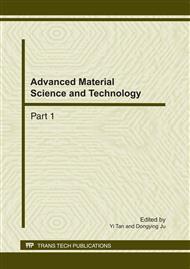p.411
p.415
p.419
p.423
p.427
p.431
p.435
p.439
p.449
Natural Fibre/Polypropylene Wrap Spun Yarns and Preforms for Structured Thermoplastic Composites
Abstract:
In the past decade, natural fibre composites with thermoplastic matrices had attracted many composites manufactures for the superiority of lightweight and low-cost. A major challenge for natural fibre composites was to achieve high mechanical performance at a competitive price. Composites constructed from yarn and fabric structure preforms were better than composites made from random nonwoven mats. However, the twist structure of conventional ring spun yarns prevented the full utilization of fibre mechanical properties in the final composites. In this paper, the wrapped yarns were produced by wrap spun method with flax and polypropylene (PP), in which all flax fibres were twistless, then woven to be fabric preforms. The PP fibres served as a carrier for flax fibres during processing and became the polymer matrix in the final composites. The homogenous distribution of fibre and thermoplastic matrix in preforms could be achieved before hot pressing, so that not lead to impregnate difficultly, and prevented damage to the reinforced nature fibres during processing. Composites made from the wrapped yarn demonstrated significant tensile and peeling properties. The fabric structures (include plain, twill, and basket weave) and yarn tensile orientation (in 0°, 90°, 45°), had great influence on tensile strength and elongation of preforms. The cavity thickness of hot pressing mould had different influence on the tensile strength and peeling strength of thermoplastic composites, and the mechanical properties were superior when the thickness was 0.8-1.2 mm. The microstructure of thermoplastic composites showed uniform infiltration between layers, and had good bonding interface between flax fibre and PP matrix in composites.
Info:
Periodical:
Pages:
427-430
Citation:
Online since:
February 2011
Authors:
Price:
Сopyright:
© 2011 Trans Tech Publications Ltd. All Rights Reserved
Share:
Citation:


